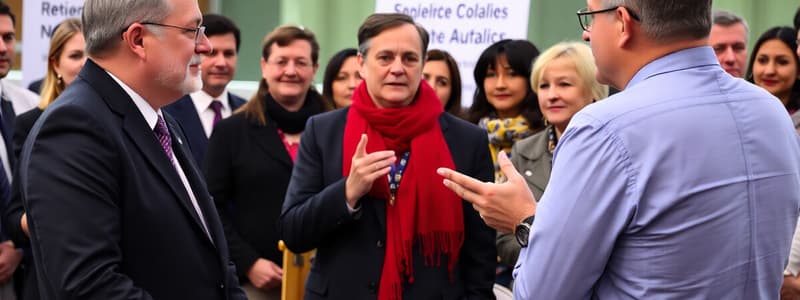Podcast
Questions and Answers
What is the primary purpose of the 'Hook' in the HLBT method for public communication?
What is the primary purpose of the 'Hook' in the HLBT method for public communication?
- To explain the details of the presentation
- To assess the knowledge of the audience
- To present a summary of the discussion
- To capture the audience's attention (correct)
What aspect does the Clan Culture primarily focus on?
What aspect does the Clan Culture primarily focus on?
- Control systems and acculturation
- Energizing employees and competition
- Interpersonal relations and personnel development (correct)
- Innovation and continuous improvement
In the context of the Organizational Culture Model, what does the Market Culture prioritize?
In the context of the Organizational Culture Model, what does the Market Culture prioritize?
- Control systems and internal coordination
- Teamwork and personnel growth
- Innovation and employee flexibility
- Customer satisfaction and competition (correct)
Which type of leader is most suitable for an Adhocracy Culture?
Which type of leader is most suitable for an Adhocracy Culture?
In order to fill out the OCAI, how many points are to be divided among the four culture types?
In order to fill out the OCAI, how many points are to be divided among the four culture types?
What is the primary distinction between influence and persuasion?
What is the primary distinction between influence and persuasion?
What percentage of the time do people typically think using the peripheral route?
What percentage of the time do people typically think using the peripheral route?
Which of the following describes the persistence of arguments when using the central route?
Which of the following describes the persistence of arguments when using the central route?
Which heuristic influence cue suggests that one should follow the actions of others?
Which heuristic influence cue suggests that one should follow the actions of others?
What is a key characteristic of the heuristic thinking mode?
What is a key characteristic of the heuristic thinking mode?
Which thinking mode relies on systematic argument evaluation?
Which thinking mode relies on systematic argument evaluation?
What type of thinking is associated with a higher resistance to change?
What type of thinking is associated with a higher resistance to change?
Which heuristic influence cue emphasizes the need for reciprocity?
Which heuristic influence cue emphasizes the need for reciprocity?
Which statement best describes the primary difference between influence and persuasion?
Which statement best describes the primary difference between influence and persuasion?
What percentage of time do people typically engage in systematic thinking according to the dual process approach?
What percentage of time do people typically engage in systematic thinking according to the dual process approach?
Which of the following cues suggests that if something is rare, it is deemed more valuable?
Which of the following cues suggests that if something is rare, it is deemed more valuable?
What is the expected persistence of arguments when thinking through the peripheral route?
What is the expected persistence of arguments when thinking through the peripheral route?
What is the main focus of leaders in a Clan Culture?
What is the main focus of leaders in a Clan Culture?
Which of the following best describes the primary function of the 'Look' in the HLBT communication method?
Which of the following best describes the primary function of the 'Look' in the HLBT communication method?
What is the focus of the Adhocracy Culture in an organization?
What is the focus of the Adhocracy Culture in an organization?
In the context of Organizational Culture, which aspect does the Market Culture prioritize?
In the context of Organizational Culture, which aspect does the Market Culture prioritize?
Which of the following leadership qualities is most essential in a Hierarchy Culture?
Which of the following leadership qualities is most essential in a Hierarchy Culture?
How many points are intended to be distributed when completing the Organizational Culture Assessment Instrument (OCAI)?
How many points are intended to be distributed when completing the Organizational Culture Assessment Instrument (OCAI)?
Which type of leadership is most suitable for fostering continuous improvement within an organization?
Which type of leadership is most suitable for fostering continuous improvement within an organization?
What does the T in the HLBT method emphasize during a presentation?
What does the T in the HLBT method emphasize during a presentation?
Flashcards
HLBT Method for Public Speaking
HLBT Method for Public Speaking
A method for structuring a presentation: Hook, Look, Body, Took.
Organizational Culture Types
Organizational Culture Types
Different organizational cultures categorized by competing values: Clan, Adhocracy, Market, and Hierarchy.
OCAI Assessment
OCAI Assessment
A tool to assess and diagnose organizational culture where you categorize 100 points among 4 types.
Clan Culture
Clan Culture
Signup and view all the flashcards
Adhocracy Culture
Adhocracy Culture
Signup and view all the flashcards
Influence vs. Persuasion
Influence vs. Persuasion
Signup and view all the flashcards
Dual Process Approach
Dual Process Approach
Signup and view all the flashcards
Central Route Thinking
Central Route Thinking
Signup and view all the flashcards
Peripheral Route Thinking
Peripheral Route Thinking
Signup and view all the flashcards
Heuristic Influence Cues
Heuristic Influence Cues
Signup and view all the flashcards
Global Business Leader's Environment
Global Business Leader's Environment
Signup and view all the flashcards
Organizational Culture Assessment Instrument
Organizational Culture Assessment Instrument
Signup and view all the flashcards
Competing Values Framework
Competing Values Framework
Signup and view all the flashcards
Clan Culture Leadership
Clan Culture Leadership
Signup and view all the flashcards
Adhocracy Culture Leadership
Adhocracy Culture Leadership
Signup and view all the flashcards
Market Culture Leadership
Market Culture Leadership
Signup and view all the flashcards
Hierarchy Culture Leadership
Hierarchy Culture Leadership
Signup and view all the flashcards
OCAI for Perfect Company
OCAI for Perfect Company
Signup and view all the flashcards
Central Route Processing
Central Route Processing
Signup and view all the flashcards
Peripheral Route Processing
Peripheral Route Processing
Signup and view all the flashcards
Comparison Cue
Comparison Cue
Signup and view all the flashcards
Liking Cue
Liking Cue
Signup and view all the flashcards
Study Notes
SKEMA Business School - Leadership: Session 5
- SKEMA Business School is accredited by EQUIS, AMBA, and AACSB.
- Session 5 focused on leadership.
- The HLBT method for public communication involves four steps:
- Hook: Grab audience attention with something interesting.
- Briefly outline what will be discussed.
- Body: The detailed information, facts, and theory.
- Conclusion: Convince the audience of the information's value.
- Session 3 focused on Organizational Design and Culture
- Different follower types are needed in various organizational cultures.
- Leader types aligned to cultural needs were discussed.
- Organizational culture models, such as Cameron and Quinn's Competing Values Framework, were covered.
- Several specific cultures were analyzed including Clan, Adhocracy, Market, and Hierarchy.
- Clan: Interpersonal relations, teams, and personnel development.
- Adhocracy: Innovation, the future, and continuous improvement.
- Market: Energizing employees, competition, customer satisfaction.
- Hierarchy: Coordination, the control system, and acculturation.
- The Global Business Leader model emphasizes environmental factors influencing leadership success, incorporating personal factors (self), relationships with others, task management, and organizational culture.
- The OCAI is a tool for assessing organizational culture. The OCAI questionnaire contains 100 points to be divided across categories A, B, C, and D. Fill it out as if the company described is the perfect company.
- The competing values frameworks (Clan, Adhocracy, Market, Hierarchy) are described in terms of competing dimensions of internal vs. external and flexibility and discretion vs. stability and control.
- Influence and Persuasion - Influence is a broader term encompassing Persuasion, which focuses on attitude change through communication.
- Two Modes of Thinking (Dual Process):
- Central Route (20%): Systematic, using arguments (hard thinking).
- Peripheral Route (80%): Heuristic, using cues (lazy thinking)
- Heuristic Influence Cues (CLARCCS): These cues influencing behavior, these include comparison, liking of source, authority of source, reciprocity, commitment and consistency, scarcity.
Studying That Suits You
Use AI to generate personalized quizzes and flashcards to suit your learning preferences.
Related Documents
Description
Explore the essential elements of leadership discussed in Session 5 at SKEMA Business School. This session emphasizes the HLBT method for effective public communication and analyzes various organizational cultures and leader types. Gain insights into the importance of aligning leadership styles with organizational needs.




